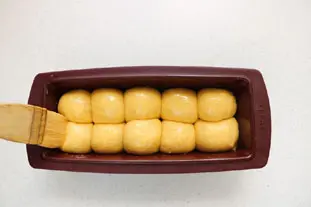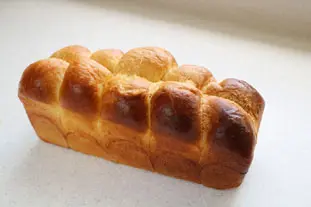The baker always gild twice

I've already told you about gilding, the beaten whole egg that is spread with a brush on anything that needs to brown in the oven: puff pastry, pastries, etc. and that professionals use a lot, I'm going to come back to this to clarify a bit how to do it, and give you a professional tip.
35 K 4.2/5 (28 reviews)
Keywords for this post:BakeryPastryGildingGlazeEggLast modified on: June 9th 2019
The baker always gild twice
"Gilding" therefore means coating the surface of something that is going to be baked withbeaten egg, the thin layer of gilding applied will colour when baked and give a very appetising appearance to your puff pastry or your pastry.
Some people, and I am one of them, think that it also influences the taste, a cake or a pastry all pale or whitish, even if it is successful "inside", will seem much less good than if it is all beautiful, all golden. What do you want, it's like this: all the senses are involved when we taste something.
It's very simple in the end, this gilding is just a brush stroke, but there is a way to do it that makes it even better. Let's imagine that you start making a brioche: you knead your dough, you put it to puff up in a warm place, then a stroke of gilding and in the oven.
This is already very good, but you can still do better, here is how:
This way of doing things, browning twice, has only advantages: Your dough will be protected from crusting during the baking process, so there's no need to cover it, and the golden colour of the brioche when baked will be even more marked.
Be careful, if it is a puff pastry that you are making, and you have planned drawings(inlays) on the top, they should only be done after the second browning.
To sum up: when you gild something, always do it twice.

Some people, and I am one of them, think that it also influences the taste, a cake or a pastry all pale or whitish, even if it is successful "inside", will seem much less good than if it is all beautiful, all golden. What do you want, it's like this: all the senses are involved when we taste something.

It's very simple in the end, this gilding is just a brush stroke, but there is a way to do it that makes it even better. Let's imagine that you start making a brioche: you knead your dough, you put it to puff up in a warm place, then a stroke of gilding and in the oven.
This is already very good, but you can still do better, here is how:
- Once finished, you put your brioche dough in its mould
- Bake the dough once, and let it rise in the warmth (we say "rising")
- Once the brioche is well pushed, you gild a second time
- Only then do you put it in the oven
This way of doing things, browning twice, has only advantages: Your dough will be protected from crusting during the baking process, so there's no need to cover it, and the golden colour of the brioche when baked will be even more marked.
Be careful, if it is a puff pastry that you are making, and you have planned drawings(inlays) on the top, they should only be done after the second browning.
To sum up: when you gild something, always do it twice.
Lasts posts
Butter vs. grease
We often read in a recipe where a pastry is put into a mould that, just before pouring, the mould should be buttered or greased. But what's the difference between these 2 terms?December 1st 20258685
Getting out of the fridge early
Very often when you're cooking, you need to take food or preparations out of the fridge, to use them in the recipe in progress. There's nothing tricky about this: you just take them out of the fridge and use them, usually immediately, in the recipe. But is this really a good method?November 24th 20251,0425
Who's making the croissants?
When you look at a bakery from the outside, you naturally think that in the bakery, the bakers make the bread, and in the laboratory, the pastry chefs make the cakes. It's very often like that, with each of these professions having quite different ways of working, but sometimes there's also one...November 23th 2025938
Oven height
When we put a dish or cake in the oven, we naturally tend to put it on the middle shelf, and that's what we usually do. But in some cases, this position and height can be a little tricky, so let's find out why.October 8th 20252,5855
The importance of sieving
In recipes that use a fine powder (flour, powdered sugar, etc.), you'll often see the advice to sift before using it. To sift is to pass the powder in question through a sieve (a very fine strainer) before incorporating it into your recipe. It's often advice, but is it really useful?September 3rd 20257,4393
Other pages you may also like
The 3 kinds of meringue
Meringue – what could be simpler? Just beaten egg whites with sugar added. This makes a fairly stiff mixture which can then be cooked in a cool oven to create those lovely, light confections. But in the world of professional patisserie, meringue comes in three different kinds. Even if the...June 14th 201364 K4.5
The so-called "nervous" meats
You've probably heard this before, we're talking about "nervous" meat, or meat with nerves, to describe what is indicated by the blue arrow on the left. This is a piece of beef, and what we call a nerve is not a nerve, it is in fact collagen (chemists sometimes call it a "collagen sink"), a...April 16th 202136 K4.5
Beans in primeur
As I write this, it is the beginning of the short season for fresh beans. If you've never made them before and you're just starting out (and that's a great idea) you'll find that it's a bit time consuming to prepare, you have to shell them once, remove the beans, scald them to remove the skin (and...June 4th 202214 K
Should I believe my oven?
Can you really trust your oven? This is an important question as we are always tempted to take the temperature indicated as gospel truth and, unfortunately, this is rarely very precise. .July 4th 201133 K4.6
Fruits which can ruin your jelly
There are many ways of making a fruit mousse, but one of the simplest is to prepare a fruit jelly (basically a fresh fruit coulis with gelatine) and then mix this jelly before it sets completely with whipped cream. The result is perfect for filling a charlotte, for example. But do beware;...March 6th 201378 K4.0
Post a comment or question
Follow this page (as 2 people already do)
If you are interested in this page, you can "follow" it, by entering your email address here. You will then receive a notification immediately each time the page is modified or a new comment is added. Please note that you will need to confirm this following.
Note: We'll never share your e-mail address with anyone else.
Alternatively: you can subscribe to the mailing list of cooling-ez.com , you will receive a e-mail for each new recipe published on the site.









